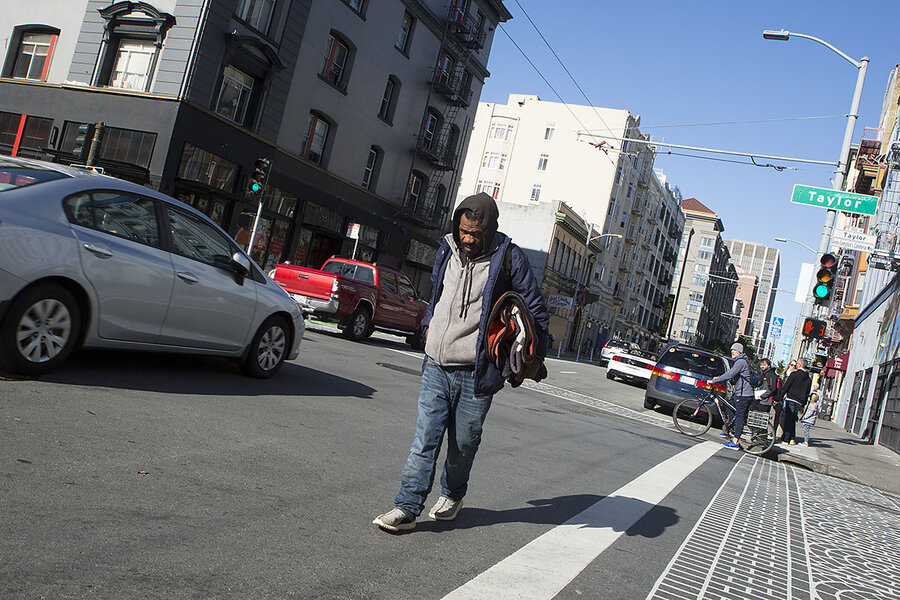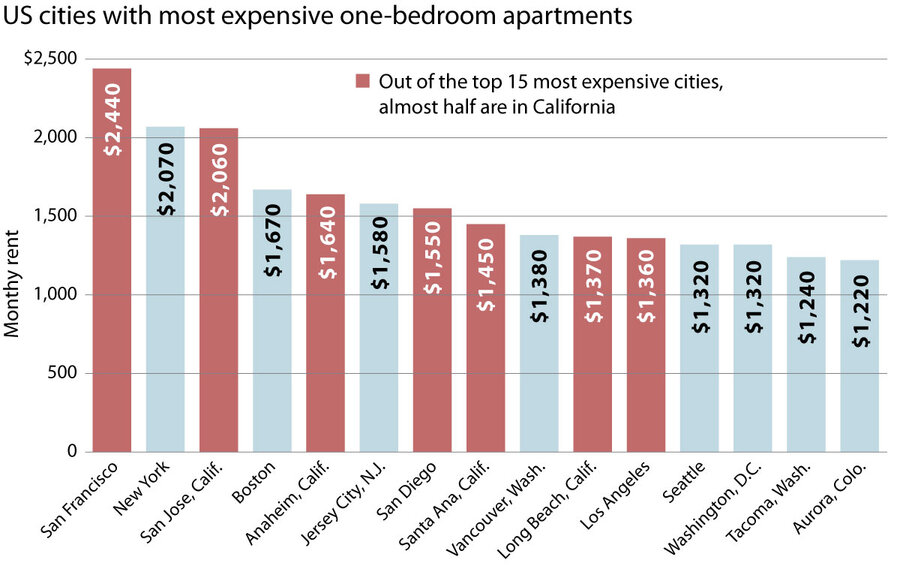Why cracking California’s homeless crisis will take more than money
Loading...
| San Francisco and Los Angeles
Homelessness has without a doubt become one of California’s most pressing issues, proclaimed by turns an emergency, a crisis, and a national disgrace.
Consider:
- As of December, about a quarter of the nation’s homeless population – about 134,000 people – lived in California, according to the Department of Housing and Urban Development (HUD).
- A San Francisco worker had to make $58.04 an hour in 2017 to afford a two-bedroom apartment at local market rate, the National Low-Income Housing Coalition (NLIHC) reports. (That works out to roughly $115,000 a year.)
- Between 2016 and 2017, the state also saw the largest increases among unsheltered homeless (more than 13,500 people) and chronically homeless individuals (nearly 6,000), according to the National Alliance to End Homelessness (NAEH).
The numbers just validate what people already see: It’s become near impossible to walk down a San Francisco block without spotting someone curled up in a corner. Tent encampments have long ago spilled out of Los Angeles’ Skid Row. Orange County officials are mired in a courtroom drama over how and where to provide services for their homeless citizenry.
Why We Wrote This
California prides itself on its progressive culture – and it has poured hundreds of millions of dollars into tackling its homeless crisis, only to see it get worse. That may be because you can't solve homelessness by just trying to solve homelessness, as one expert puts it.
Similar stories are being told in Fresno and San Diego, Butte County and Imperial County. No wonder housing was a main character Tuesday night in the final debate among the state’s six candidates for governor.
It’s not that homeless advocates are at a loss: Decades of research show that the best way to reduce homelessness is to put roofs over people’s heads as quickly as possible, then provide the right array of services – such as short-term cash infusions or more intense mental health assistance – to get them on their feet and out of the system. It’s a strategy called “housing first.”
Knowing, however, isn’t the same as doing. Tech companies, nonprofits, and other entities have poured millions, if not billions, of dollars into “fixes” for homelessness over the years, including tiny homes, Kickstarter campaigns, even apps. The City of San Francisco spent $275 million on homelessness and supportive housing in fiscal 2016, up from $241 million the year before. Social service providers, along with government and the private sector, are still catching up to fund and build infrastructure based on best practices, advocates say.
“Everybody loves innovation, and everybody loves the big solution. We invest money based on the shiniest idea or the loudest voice in the room,” says Jeff Kositsky, director of San Francisco’s Department of Homelessness and Supportive Housing. “But sometimes it’s just hard work.”
The underlying causes
Another huge issue is inflow. Especially in major metro areas, and especially in California, housing costs are soaring beyond what incomes can sustain. The daily stream of newly homeless people often outpaces providers’ ability to rehouse the existing homeless. Until and unless that equation balances out, better services – already a challenge to administer – won’t be able to move the needle.
“Way too often we try to solve homelessness by just solving homelessness, as opposed to solving the underlying drivers pushing people into homelessness,” says Adam Murray, executive director of Inner City Law Center, which provides legal services for poor families in Los Angeles. “There’s not nearly enough attention put in place on homelessness prevention and, more generally, on affordability of housing for extremely low-income folks.”
For providers, he says, that means “even if you’re doing an amazing job, you’re just in that hamster wheel.”
Homelessness wasn’t always so visible or seemingly intractable. When the issue in its modern form first began drawing national attention in the 1980s, advocates focused on providing shelters. The idea, says NAEH executive director Nan Roman, was to get people into a safe place for a night or two and offer light assistance around budgeting, employment, and substance abuse. The approach evolved into a kind of merit process: if a person who entered a shelter proved they could abide by the rules – if they could stay off alcohol and drugs and maybe find a job – then they would qualify for permanent housing.
But the problem didn’t go away. Researchers and social service workers began to realize that they were looking at the issue backwards: you couldn’t expect a person to kick their bad habits, find a job, and send the kids to school before you proclaimed them “ready” for housing. How could a mother focus on interviews or enroll her children in school when she doesn’t know where her family is going to spend the night?
“Housing is a basic need; it’s the platform on which everything else happens,” Ms. Roman says. “When you don’t have your own place, you can’t really concentrate on the services.”
The new approach came with an acknowledgment of the larger forces that lead to homelessness.
Policy decisions in the mid-1990s pared down federal welfare programs, following 1980s moves in which HUD had done the same for public housing and rent subsidies. Fewer affordable housing units were built, and millions of those that existed were torn down or repurposed. The mid-20th century also saw a movement to shift treatment for the mentally ill from state hospitals to community, and often private, facilities. Tens of thousands of state hospitals closed, and many of the patients they released, instead of seeking treatment elsewhere, ended up on the streets.
The economy shifted, too, as manufacturing began its long decline. Rust Belt states are often associated with the closing down of US factories, but thousands of aerospace jobs, for instance, left Los Angeles, as well.
Today the US is short about 7.4 million affordable housing units. In California, where zoning regulations and other laws make it even harder to build, more than 500 cities and counties are failing to develop enough affordable and market-rate housing to keep pace with population growth, according to the state housing department. L.A County alone has a gap of about 550,000 units.
‘It is much harder to be poor now’
Meanwhile, wages – especially for the poorest Americans – have not kept up with rising housing costs. The NILCH report found that the average US worker making the federal minimum wage of $7.25 an hour would have to put in more than 94 hours a week to afford the monthly market rate of $1,103 for a two-bedroom unit. In California, a worker making the 2017 state minimum of $10.50 an hour would have to work three full-time jobs – 120 hours – to afford a two-bedroom apartment.
And poorer families tend to spend a much larger share of their incomes on housing and other basic needs than their wealthier counterparts, who are more likely to put their money into insurance and retirement.
“It is much harder to be poor now than it was than 1970,” says Paul Tepper, head of the Western Center on Law and Poverty and co-author of a 2007 report that looks at the historical causes of modern homelessness in L.A. “Poor people simply cannot afford housing. So more people are perched on the edge.”
Still, there’s been progress. In 2017, the national rate of homelessness per 10,000 people hit a record low and overall homelessness has dropped more than 14 percent since 2007, when the Great Recession began. States like California have increased their capacity to house and shelter the homeless.
“The homeless system is getting really awesome at rehousing people who become homeless,” says Ms. Roman at NAEH. “But as good as we get at turning it around, more people are coming in the front door.”
Community resistance to new development and lingering stereotypes about the homeless have proven to be persistent challenges, Ms. Roman and others say. And even those who support new housing disagree about how and where to build. Case in point: the speedy demise of California Senate Bill 827, which would have substantially increased housing development at transit stations across the state. Meant to combat rising housing costs and address the affordable housing gap, S.B. 827 saw opposition from NIMBY (“Not in my backyard”) elements as well as low-income tenant activists who said the bill could end up displacing poor and minority families. The measure died in a state legislative panel in April.
Money is another problem. President Trump’s proposed budget includes a slight funding bump for HUD for 2019, but that won’t be enough to make up for the decades of cuts the department has endured. The same goes for the major funding measures that Los Angeles voters passed last year to address homelessness in the region, advocates say: While unprecedented, the state still has a ways to go before it can catch up to need.
“It’s a wicked problem,” says Brenda Wiewel, executive director of the University of Southern California’s Initiative to Eliminate Homelessness. “It’s so deeply intertwined with norms and values and systemic issues that are all in place. You can reduce and get rid of one barrier, but then several others pop up.”
Back in San Francisco, Mr. Kositsky says the big ask is to get more people viewing homelessness from a systems perspective and build a better, more cost-effective safety net for those fall through the cracks. “You shoot for these ridiculous goals, and you don't end up investing where you need to invest,” he says. “I’m looking at where there are gaps in the system that we can fill inexpensively that can have big impact. How do we make sure that every dollar we have gets used as effectively as possible?”
[Editor’s note: The original version of this story misstated the bill number for S.B. 827.]










